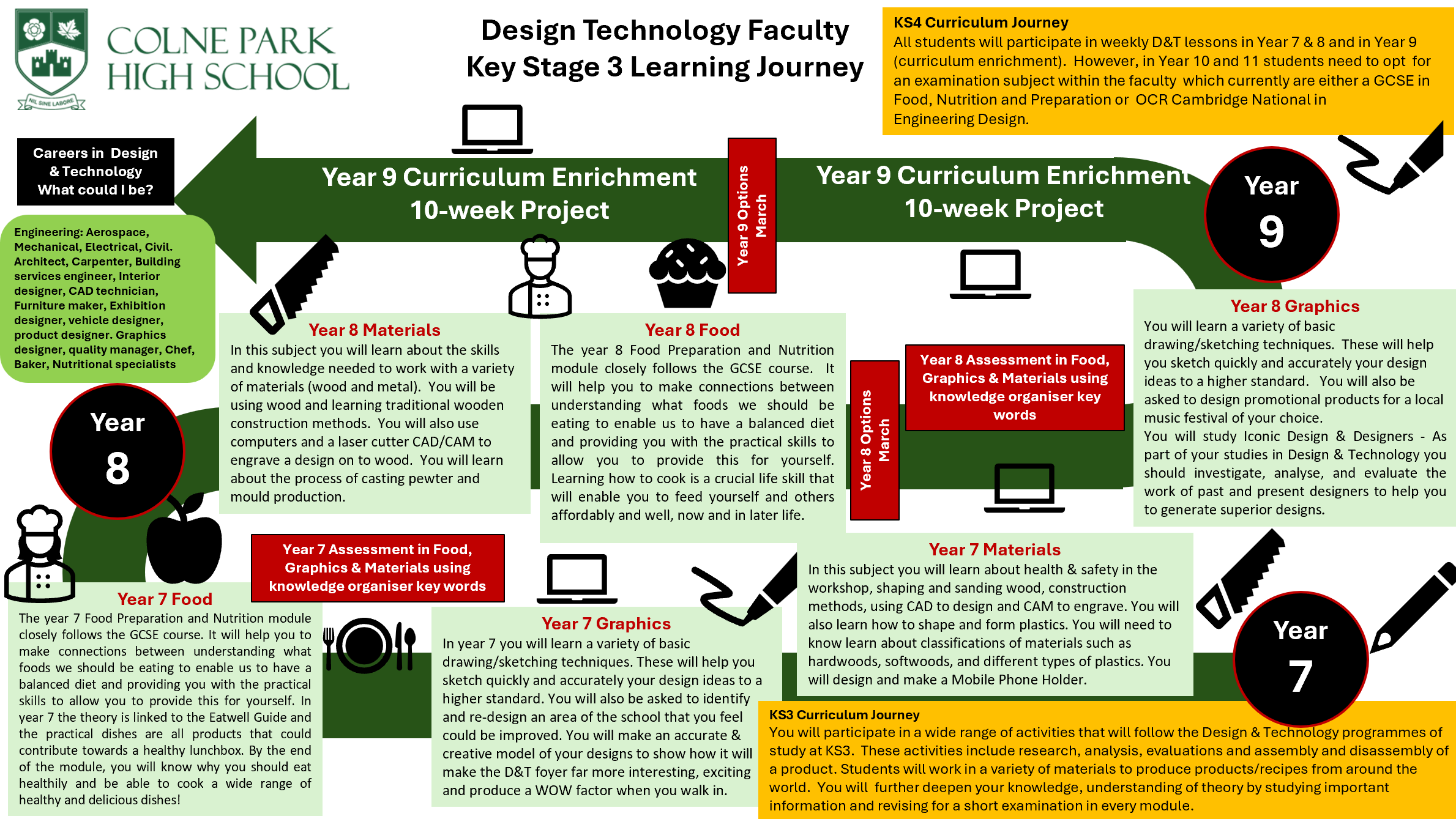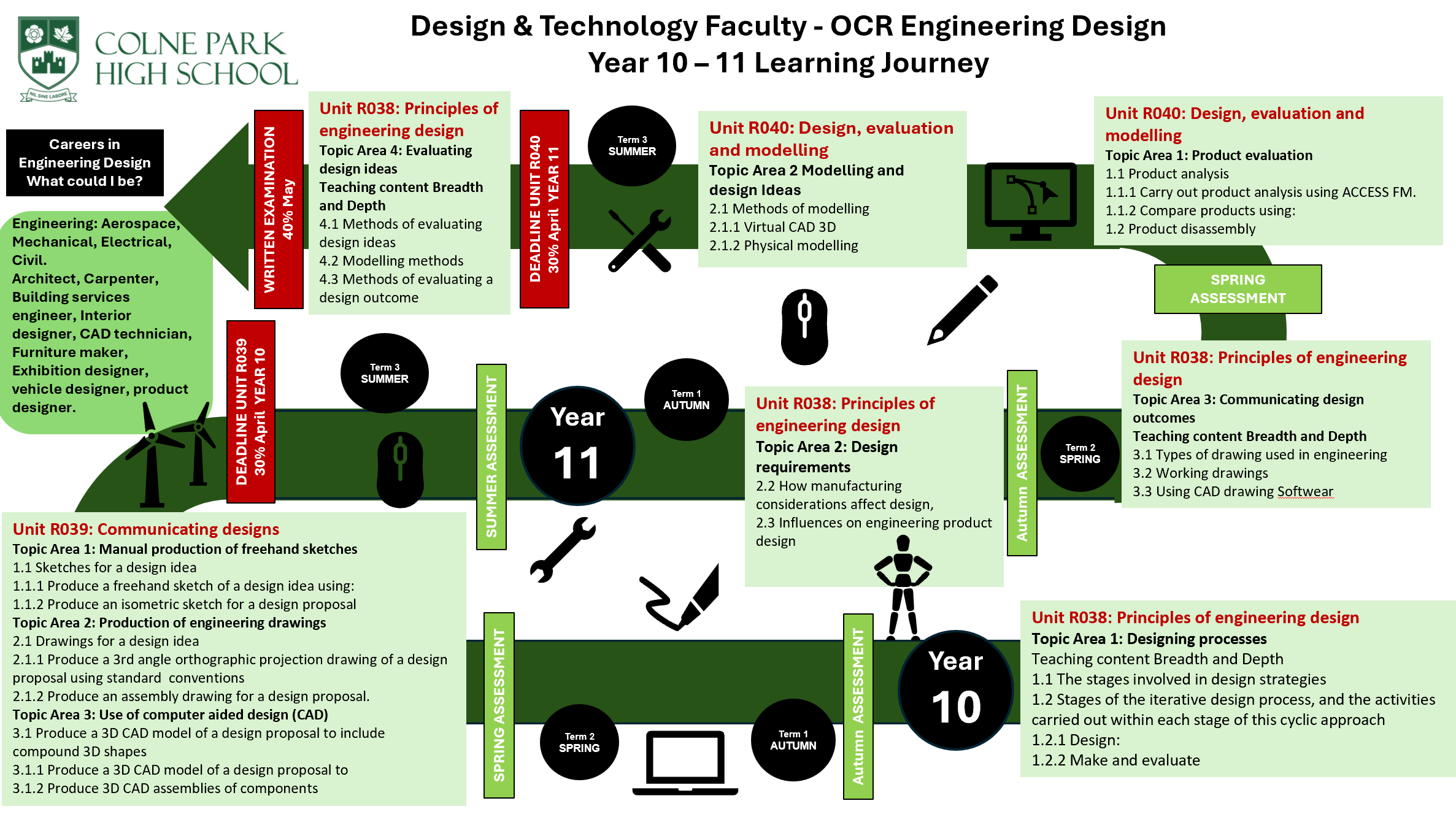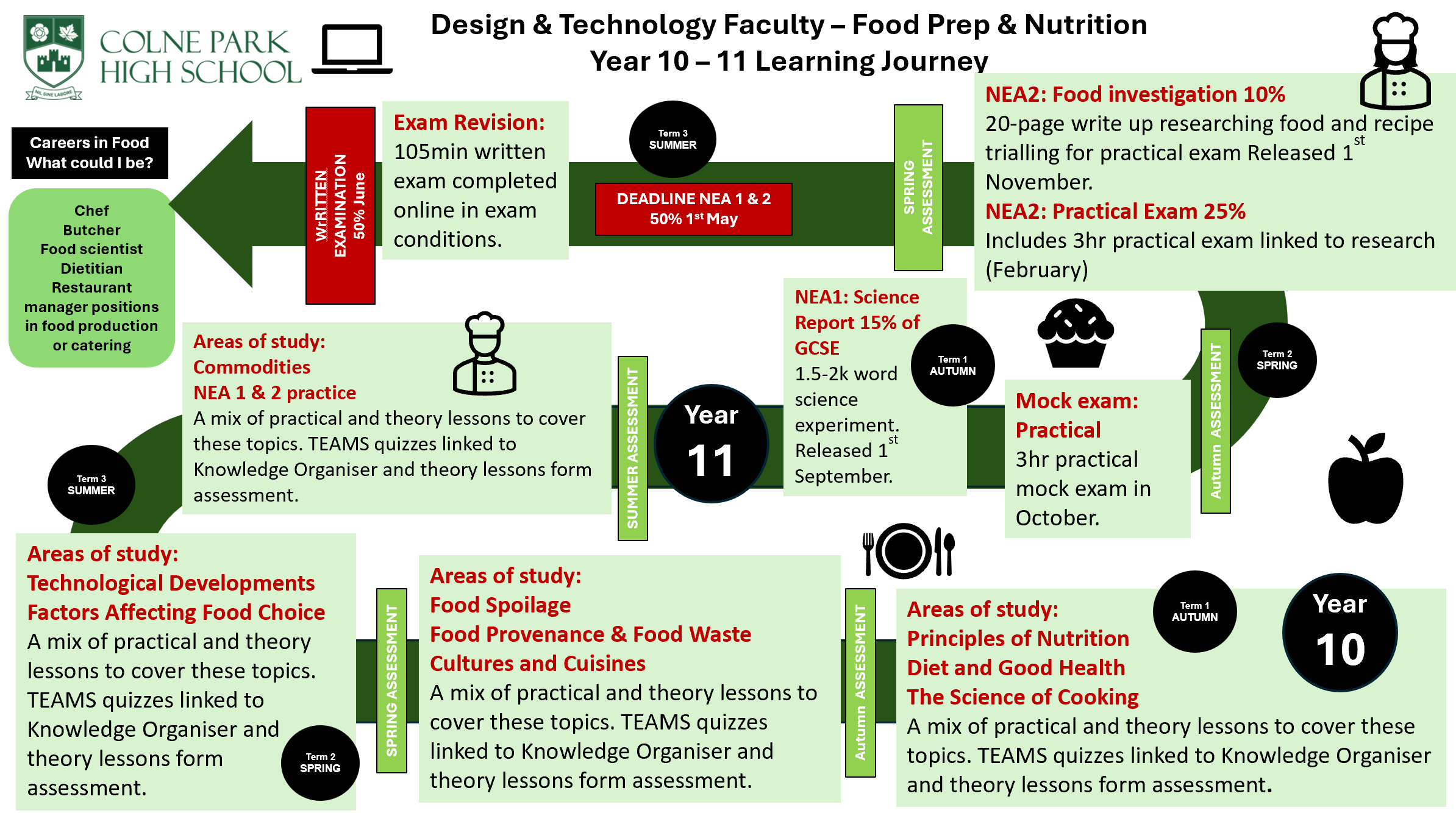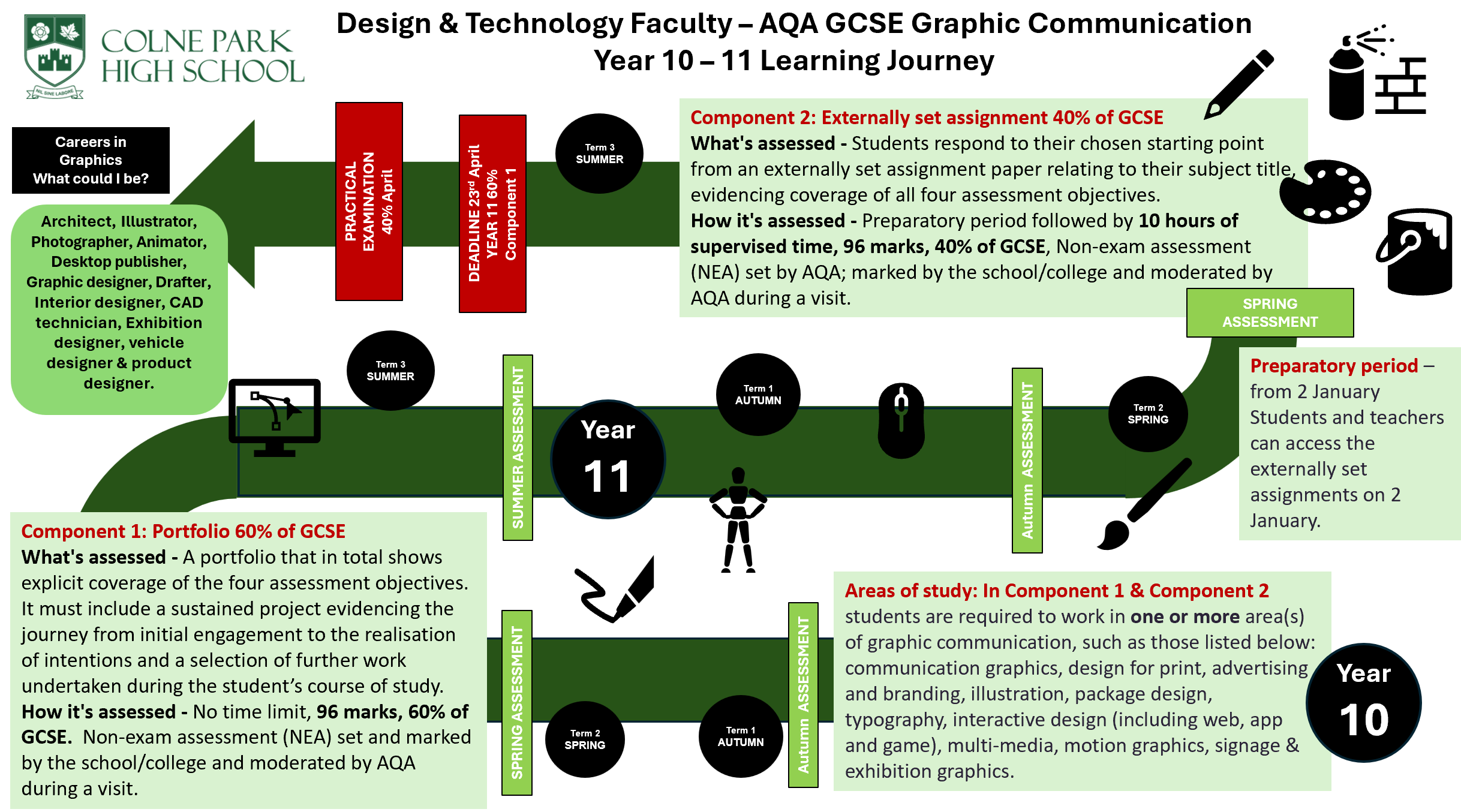Design & Technology

Mr Craig Greenwood - Curriculum Leader for Design & Technology
Design and Technology is an inspiring, rigorous and practical subject. Using creativity and imagination, pupils design and make products that solve real and relevant problems within a variety of contexts, considering their own and others’ needs, wants and values. They acquire a broad range of subject knowledge and draw on disciplines such as mathematics, science, engineering, computing and art. Pupils learn how to take risks, becoming resourceful, innovative, enterprising and capable citizens. Through the evaluation of past and present design and technology, they develop a critical understanding of its impact on daily life and the wider world. High-quality design and technology education makes an essential contribution to the creativity, culture, wealth and well-being of the nation.
Our intent at Park High is to provide a curriculum that is logically planned and progressive. A curriculum that is cumulative giving students sufficient knowledge and skills for future learning and employment. This will be achieved through carefully planned, methodical Schemes of work where opportunities are built upon from KS3 into KS4. Subject knowledge and skills will be inter-weaved through each of our faculty subjects, projects and year groups to ensure a deeper understanding and the confidence to achieve.
We have high expectations of all our students and endeavour to create and promote a positive, creative, nurturing, motivational, independent and resilient working environment. Our Faculty staff strive to challenge, are encouraged to develop their own individual craft and pedagogy for the subject and place the students at the fore of all they do.
The Design & Technology faculty is dynamic and forward thinking, we help the students to develop a critical understanding of the impact the curriculum contents will have on daily life and as they move into the wider world.
Key Stage 3 Design and Technology

When undertaking a project in a Design and Technology subject area, at Park High School, students follow the new National Curriculum aims listed below as they follow the design process in making successful and marketable products:
- develop the creative, technical and practical expertise needed to perform everyday tasks confidently and to participate successfully in an increasingly technological world
- build and apply a repertoire of knowledge, understanding and skills in order to design and make high-quality prototypes and products for a wide range of users
- critique, evaluate and test their ideas and products and the work of others
- understand and apply the principles of nutrition and learn how to cook
How this is delivered at Park High School:
Through a variety of creative and practical activities, students are taught the knowledge, understanding and skills needed to engage in an interactive process of designing and making. We operate a rotation system where students study all aspects of Technology including Food, Materials, Graphic Communication.
Design
• Use research and exploration, such as the study of different cultures, to identify and understand user needs.
• Identify and solve their own design problems and understand how to reformulate problems given to them.
• Develop specifications to inform the design of innovative, functional, appealing products that respond to needs in a variety of situations.
• Use a variety of approaches to generate creative ideas and avoid stereotypical responses.
• Develop and communicate design ideas using annotated sketches, detailed plans, 3-D and mathematical modelling, oral and digital presentations and computer-based tools.
Make
• Select from and use specialist tools, techniques, processes, equipment and machinery precisely, including computer-aided manufacture.
• Select from and use a wider, more complex range of materials, components and ingredients, taking into account their properties.
Evaluate
• Analyse the work of past and present professionals, design eras and others to develop and broaden their understanding.
• Investigate new and emerging technologies.
• Test, evaluate and refine their ideas and products against a specification, taking into account the views of intended users and other interested groups.
• Understand developments in design and technology, its impact on individuals, society and the environment, and the responsibilities of designers, engineers and technologists
Technical knowledge
• Understand and use the properties of materials and the performance of structural elements to achieve functioning solutions
• Understand how more advanced mechanical systems used in their products enable changes in movement and force.
• Understand the importance of CAD/CAM in prototyping and within commercial production.
Cooking and nutrition
As part of their work with food, students are taught how to cook and apply the principles of nutrition and healthy eating. Learning how to cook is a crucial life skill that enables students to feed themselves and others affordably and well, now and in later life. Students are taught to:
- understand and apply the principles of nutrition and health.
- cook a repertoire of predominantly savoury dishes so that they are able to feed themselves and others a healthy and varied diet.
- become competent in a range of cooking techniques.
- understand the source, seasonality and characteristics of a broad range of ingredients.
Engineering Design
Engineering Design is a process used to identify market opportunities and solve problems which contribute to the development of new products and systems. This qualification is aimed at learners who wish to study the process involved in designing new engineered products and the requirements of a design specification. Through research and practical activities, learners will use practical skills such as drawing, computer modelling and model making to communicate design ideas.
The course is currently made up of three mandatory components. 40% written examination and two NEA (non-examined assessments).
Students will undertake three NEA tasks. Product Analysis and Research. Developing and Presenting Engineering Designs. 3D Design Realisation.
The Cambridge Nationals in Engineering Design encourage learners to communicate and consult with a client to develop a viable and innovative product. Learners will apply practical skills to produce a prototype in the form of a model and test design ideas to inform further product development. Through reflection, learners evaluate the prototype, making a comparable outcome against specification points, and access possible, practical solutions and improvements to their prototype design.
Potential Courses:
- Architecture
- Civil engineering
- Car design
- Mechanical engineering
- Product designer
- Industrial design
- Aerospace engineer
- Nautical engineer
Potential Careers:
- Product design
- 3D design
- Engineering
- Industrial design
- Architecture
- Art and design
- Architecture
- Product design
Full Specification for OCR Engineering Design Cambridge National J822 Level 1/Level2
Curriculum Map:

Food Preparation & Nutrition
Food Preparation & Nutrition equips our students with an array of culinary techniques, as well as knowledge of Nutrition, Food Science, Provenance and Kitchen Safety. We aim to develop a greater understanding of the range of food available, the benefits of eating a healthy diet and increased awareness of food security, promoting a love of food, confidence and independence in the kitchen.
The course is 50% examination and 50% NEA (non-examined assessment).
Students will undertake two NEA tasks, one which is a Food based investigation (15%) set by the exam.
The second NEA (35%) is a practical assessment, again based on an exam board task set during the Autumn term, this will involve students in research, trialling, planning, preparing and cooking dishes and evaluating their work. The final examination is taken in the Summer Term. Studying this subject provides essential life skills and knowledge and also opens pathways for many career opportunities.
Food is a subject for life. We teach the underlying principles and skills to live a healthy life. We embrace current nutritional thinking and up-to-date practices. We utilise a lot of practical sessions and our pupils develop high-level culinary skills. At Park incorporate as many learning experiences as possible, delivered in a variety of styles including the frequent use of sensory testing.
Potential Courses:
|
Food microbiology |
Food plant safety and hazard analysis |
|
Food processing |
Management of food processing industries |
|
Food and vegetable processing |
Bakery and confectionary technology |
|
Crop processing technology |
Food packaging technology |
Potential Careers:
Barista
Brewery worker
Chef
Dietitian
Farm manager
Food scientist
Nutritional therapist
Full specification GCSE EDUQAS Food Preparation and Nutrition
Curriculum Map:

Graphic Communication
Students are required to develop knowledge, understanding and skills relevant to Graphic Communication through integrated practical, critical and contextual study that encourages direct engagement with original works and practice. Students may work in any medium or combination of media. They can work entirely in digital media or entirely non-digital media, or in a mixture of both, provided the aims and assessment objectives are met. Students must learn through practical experience and demonstrate knowledge and understanding of sources that inform their creative intentions. Intentions should be realised through purposeful engagement with visual language, visual concepts, media, materials and the application of appropriate techniques and working methods. Students must develop and apply relevant subject-specific skills in order to use visual language to communicate personal ideas, meanings and responses. Students must, over time, reflect critically upon their creative journey and its effectiveness in relation to the realisation of personal intentions.
There are two mandatory components. 60% NEA (Non Examined Assessment). 40% Externally set assignment.
The two components, comprising a ‘Portfolio’ selected from the course of study and an ‘Externally set assignment’, the specification provides a range of creative, exciting and stimulating opportunities to develop and explore personal interests in Graphic Communication. It allows for progression from Key Stage 3 whilst providing a strong foundation for further study at AS and A-level as well as vocational pathways.
Potential Courses:
- Architecture
- Graphic design
- Car design
- Interior design
- Product designer
- Industrial design
- Aerospace engineer
- Nautical engineer
Potential Careers:
- Advertising art director
- Animator
- Art worker
- Concept artist
- Creative director
- Graphic designer
- Illustrator
Full specification AQA Graphic Communication
Curriculum Map:

